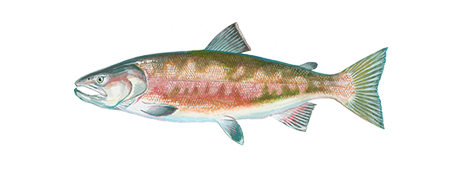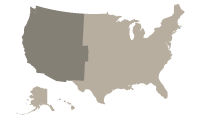
Chum Salmon
Chum salmon are not as popular or as desirable as other Pacific salmons although it is still considered a fine food fish, particularly when smoked.

Region
West
Catch ease
Medium
Habitat
Bay, River, Ocean
How to identify a Chum Salmon
At sea, chum salmon are silvery and have no distinct black spots, though they may have fine black speckling on the upper sides and back. Spawning males turn olive green with blood red vertical markings reaching up the sides, making this one of the most easily recognized Pacific salmon species. The color of spawning females is less vivid, but essentially the same. Breeding males of the species have large, exposed teeth, which may be the origin of the name “dog salmon,” though it is also said that this name evolved because this species was often fed to sled dogs. These fish average around 5-10 pounds but fish of up to 25 pounds are fairly common.
Where to catch Chum Salmon
The chum salmon is endemic to the Pacific and Arctic oceans, Bering Sea, the Sea of Japan and the Okhotsk Sea. In North America it occurs from the San Lorenzo River, California, to northwest Alaska, and east to the Peel, MacKenzie and possibly Anderson Rivers in Canada. During spawning it is known to ascend some rivers for considerable distances with some fish traveling over 1,200 miles. In the MacKenzie River, N.W.T., Canada, chum salmon travel all the way to the mouth of the Hay River and to the rapids below Fort Smith on the Slave River, entering both Great Bear and Great Slave Lakes and traveling through the Northwest Territories to the edge of Alberta, Canada. Like all Pacific salmons, with the exception of landlocked specimens, the chum salmon is anadromous and will spend most of its life in the ocean until spawning time when it enters freshwater rivers. The following list includes additional details on where to catch this fish:
| Backflow |
| Channel Entrances |
| Man-Made Structures |
| Outsides of Bends |
| Rivers and Streams |
| Schools |
| Drop-Offs |
| Merging Currents |
| Undercuts |
| Bays and Estuaries |
| Coastal Waters |
| Merging Water |
| Ripples, Currents, Swirls and Sprays |
| Rock and Boulder Pockets |
| Dams and Falls |
| Eddies |
| Small Pointed Waves |
| Current Edges |
How to catch Chum Salmon
Most anglers target this species with light spin casting or fly tackle because chum salmon tend to be very light biting fish, meaning they will not aggressively strike baits and lures like other species of fish. Many of the chum salmon that are caught are caught while targeting other species of fish.It begins entering river mouths after mid-June and reaches some spawning grounds as late as November or December. This late run severely affects its utilization as a sport fish because of weather restrictions put on anglers, and it is not one of the most sought after salmon species by anglers. The following are fishing methods used to catch this fish:
Chum Salmon lures, tackle & bait
The following are lures, tackle or bait that can be used to catch this fish:
